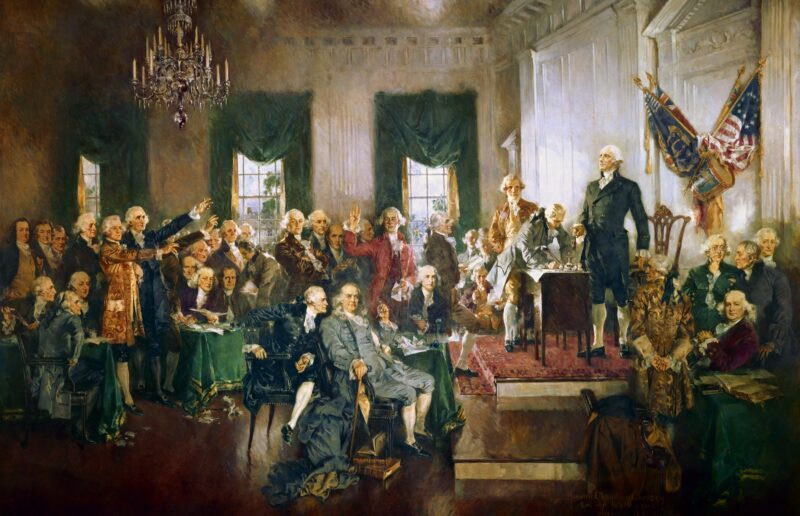The Bill of Rights
In Summary
“A bill of rights is what the people are entitled to against every government on earth, general or particular, & what no just government should refuse or rest on inference.”
Thomas Jefferson to James Madison
December 1787
The primary complaint from Anti-Federalists after the convention was the exclusion of a bill of rights from the Constitution. By 1787, most state constitutions included a bill of rights or listed similar rights directly in the body of their constitutions. Framers who supported a bill of rights in the U.S. Constitution believed the people needed the same protection from the central government as they did from the state governments. One argument against the inclusion of a bill of rights was that by listing certain rights, it would be implied that any right not listed is automatically forfeited. The sources here include precursors to the U.S. Bill of Rights, debates from the Constitutional Convention, and modern ideas about bills of rights and what they ought to include. Learn more about the Bill of Rights on the Bill of Rights Discovery Page and the Bill of Rights Collaborative Curriculum.
JMC Resources

Precursors to the Bill of Rights
The Stamp Act was one of the pieces of legislation that angered colonists the most. In response to the Act, representatives from nine colonies convened to draft the Declaration of Rights and Grievances of the Stamp Act. It was the first collective action of the colonies to resist British taxation and which ultimately led to the American Revolution. The Declaration asserted that colonists have the same rights as Englishmen and served as a foundational document for the Constitution and Bill of Rights.
Declaration of Rights and Grievances of the Stamp Act, 1765
In 1774, twelve colonies sent delegates to the First Continental Congress (all except Georgia) to respond to the Coercive Acts. The product of the convention was the Declaration and Resolves of the First Continental Congress. Many of the rights claimed by the delegates reflected both rights held by Englishmen and natural rights. The U.S. Constitution and Bill of Rights use some of the same language used in the Declaration and Resolves.
Declaration and Resolves of the First Continental Congress, 1774
In June 1776, the government of Virginia adopted the Virginia Declaration of Rights. It influenced the Declaration of Independence, the Articles of Confederation, the U.S. Constitution, and the Bill of Rights. Consider the similarities and differences between the three documents below and how they each may have influenced the U.S. Bill of Rights.
Virginia Declaration of Rights, 1776
Articles of Confederation, Article III, 1781

Debates at the Convention
The two speeches by Edmund Randolph and James Madison at the beginning of the Constitutional Convention set out expectations about what will be accomplished by the delegates. Though the speeches are not about a bill of rights, both emphasize republican principles of government and correcting injustices that have occurred under the Articles of Confederation.
Edmund Randolph and James Madison at the Constitutional Convention, 1787
Thomas Jefferson and James Madison corresponded regularly on a wide range of topics. Between 1787 and 1789, they exchanged multiple letters discussing a bill of rights for the country. These excerpts of their personal letters reveal how the two men thought about a bill of rights and the role it would play in protecting citizens from an unjust government.
Exchange between Thomas Jefferson and James Madison, 1787-1789
In this Federalist Paper, Publius addresses New Yorkers who are unhappy with the lack of a bill of rights in the proposed Constitution. He responds to two specific complaints New Yorkers have and claims that the Constitution is already a bill of rights in itself.

The Original Bill of Rights
James Madison introduced a bill of rights to Congress in 1789 that included 12 amendments. Though he originally opposed a bill of rights, he eventually became a leading advocate of the amendments to secure individual rights. Below is a transcript of Madison’s speech to the House of Representatives introducing the Bill of Rights, the original 12 amendments with the 10 that were eventually ratified by the states, and a link to images of the original senate markup of Madison’s original proposal.
James Madison speech to Congress, June 8, 1789
Original Senate Markup of the Bill of Rights, September 9, 1789

Modern Proposals
In more recent history, politicians have called on governments to secure economic rights for individuals with constitutional amendments. President Franklin D. Roosevelt outlines his vision of an economic bill of rights for Americans in the second half of his 1944 State of the Union Address. Debates about economic rights have also occurred at the state level. Excerpts from the Maryland State Constitutional Convention in 1967-68 show the debate between representatives about including economic rights in the Maryland Constitution.
Franklin D. Roosevelt, State of the Union Address, 1944
Debates in the Maryland Constitutional Convention of 1967-68
Other Resources
The Bill of Rights for Real Life
Bill of Rights Institute
The Bill of Rights and You: Rights and Responsibilities
Bill of Rights Institute
Preserving the Bill of Rights
Bill of Rights Institute
The Creation of the Bill of Rights
NEH EDSITEment!
The Debate Over a Bill of Rights
Center for the Study of the American Constitution